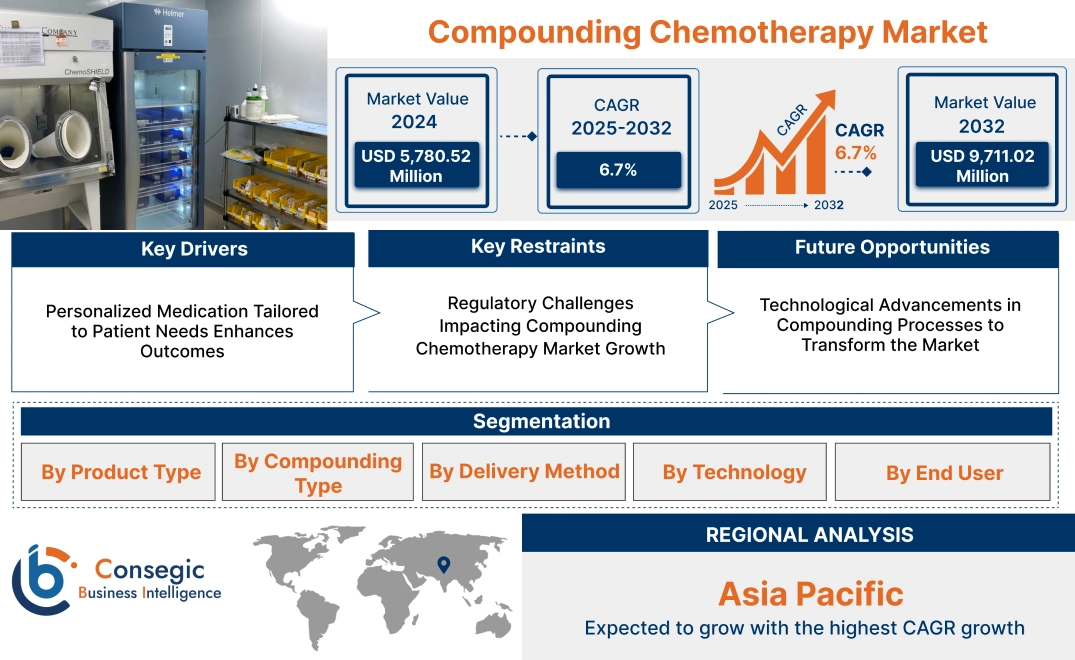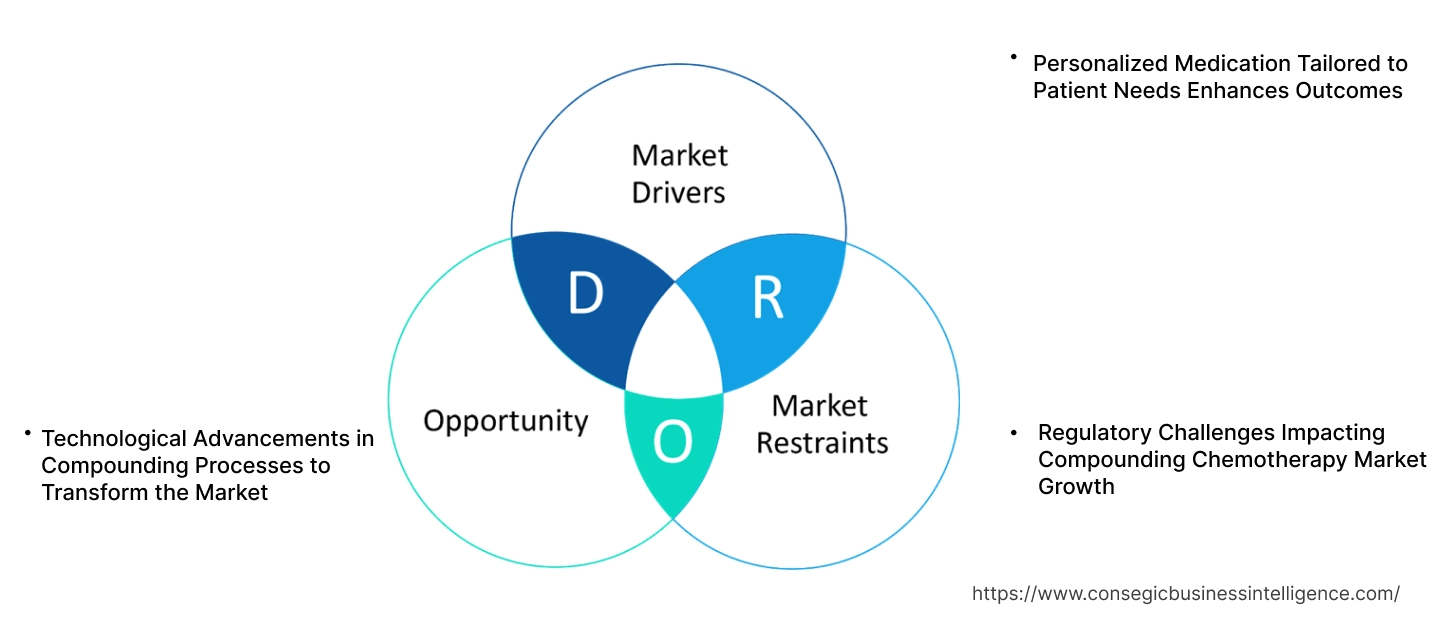- Summary
- Table Of Content
- Methodology
Compounding Chemotherapy Market Size:
Compounding Chemotherapy Market size is estimated to reach over USD 9,711.02 Million by 2032 from a value of USD 5,780.52 Million in 2024 and is projected to grow by USD 6,064.82 Million in 2025, growing at a CAGR of 6.7 % from 2025 to 2032.
Compounding Chemotherapy Market Scope & Overview:
Compounding chemotherapy involves the preparation and customization of chemotherapy drugs to meet specific patient requirements. It ensures precise dosage, sterility, and tailored formulations for optimal treatment efficacy. Key characteristics include adherence to stringent compounding standards, advanced equipment for aseptic processing, and specialized storage conditions to maintain drug integrity. The process incorporates quality control measures to ensure accurate preparation and safe administration.
The benefits include reduced medication errors, improved patient safety, and the ability to address unique clinical needs, such as allergen-free or pediatric-specific formulations. It supports personalized treatment strategies for cancer care. Applications include hospitals, oncology clinics, and specialty pharmacies. End-use industries encompass healthcare facilities, cancer research institutions, and pharmaceutical compounding service providers. These entities rely on compounding chemotherapy to enhance cancer treatment outcomes and operational efficiency.
Key Drivers:
Personalized Medication Tailored to Patient Needs Enhances Outcomes
The expansion for personalized chemotherapy treatments has increased as healthcare systems focus on tailored patient care. Compounding chemotherapy allows pharmacists to customize drug formulations, dosages, and combinations based on a patient's unique health profile, minimizing side effects and maximizing therapeutic outcomes. For instance, patients with specific genetic markers or co-morbid conditions benefit from formulations adjusted to their physiological needs, improving efficacy.
Therefore, the precision offered by compounded chemotherapy in addressing individual patient requirements significantly contributes to the compounding chemotherapy market expansion.
Key Restraints:
Regulatory Challenges Impacting Compounding Chemotherapy Market Growth
The compounding of chemotherapy drugs is subject to stringent regulations to ensure patient safety and product quality. Compliance with these regulations requires specialized facilities, skilled personnel, and periodic inspections, which increase operational costs and restrict the entry of smaller players. Additionally, the complexity of adhering to guidelines such as those from the FDA or EMA often delays product approvals and disrupts supply chains.
Thus, the rigorous regulatory landscape creates hurdles for market participants, impeding compounding chemotherapy market growth.
Future Opportunities :
Technological Advancements in Compounding Processes to Transform the Market
The integration of automation and digital technologies in compounding processes is anticipated to reshape the chemotherapy market. Robotic compounding systems and AI-driven quality control mechanisms are expected to enhance accuracy, reduce contamination risks, and increase production efficiency. For example, robotic systems designed for sterile compounding can precisely measure and mix chemotherapy drugs, ensuring consistency and safety.
Therefore, the adoption of advanced technologies is projected to create lucrative compounding chemotherapy market opportunities for innovation and scalability.
Compounding Chemotherapy Market Segmental Analysis :
By Product Type:
Based on product type, the compounding chemotherapy market is segmented into chemotherapy drugs, supportive care medications, and adjunctive agents.
Chemotherapy Drugs accounted for the largest revenue in compounding chemotherapy market share by 61.50% in 2024.
- Chemotherapy drugs are designed to target and destroy cancer cells, playing a crucial role in oncology treatments. These drugs are used to treat various cancers, including breast, lung, and colorectal cancers.
- They offer a range of benefits, such as effectively shrinking tumors, eliminating cancer cells, and preventing the spread of cancer. The trend for these drugs is significant due to their vital role in cancer treatment protocols.
- Increasing prevalence of cancer, advancements in personalized medicine, and growing adoption of chemotherapy in cancer treatment contribute to the high demand for chemotherapy drugs.
- Consequently, chemotherapy drugs are pivotal in the compounding chemotherapy market, providing significant revenue and compounding chemotherapy market trend.
- Therefore, according to compounding chemotherapy market analysis, chemotherapy drugs continue to dominate the compounding chemotherapy market due to their essential role in cancer treatment, contributing to a steady revenue stream.
Supportive Care Medications is anticipated to register the fastest CAGR during the forecast period.
- Supportive care medications are used to manage the side effects of chemotherapy, such as nausea, pain, and fatigue. These medications improve the quality of life for cancer patients undergoing chemotherapy treatments.
- The increasing focus on patient comfort and the rising incidence of chemotherapy-related side effects are propelling the expansion for supportive care medications.
- Furthermore, advancements in supportive therapies, including anti-nausea treatments and pain management solutions, are expected to drive the compounding chemotherapy market trend.
- Thus, according to compounding chemotherapy market analysis, the supportive care medications segment is poised for rapid growth, driven by an increasing focus on alleviating chemotherapy side effects and improving patient quality of life.
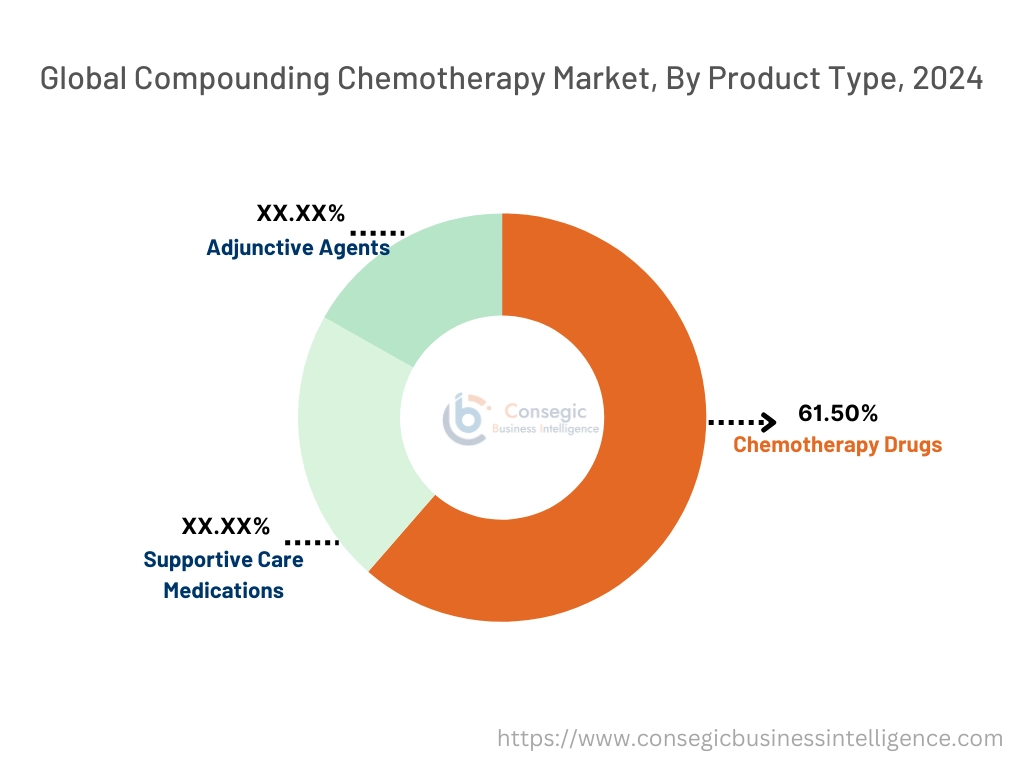
By Compounding Type:
The compounding chemotherapy market is segmented into sterile compounding and non-sterile compounding.
Sterile Compounding accounted for the largest revenue in compounding chemotherapy market share in 2024.
- Sterile compounding involves the preparation of chemotherapy drugs in an environment free from bacteria and contaminants. It is a crucial part of ensuring the safety and efficacy of chemotherapy treatments.
- The demand for sterile compounding has risen due to the increasing need for customized doses of chemotherapy drugs for cancer patients.
- In addition, regulatory standards for sterile preparation, particularly in hospitals and oncology centers, further drive the trend of this segment
- As chemotherapy treatments become more specialized and tailored, the sterile compounding market is expected to maintain dominance.
- Therefore, according to market analysis, sterile compounding remains the dominant segment due to its essential role in ensuring safety, quality, and regulatory compliance in chemotherapy treatments.
Non-Sterile Compounding is expected to register the fastest CAGR during the forecast period.
- Non-sterile compounding includes the preparation of medications not intended for injection or intravenous use. These compounded drugs are often used in cancer treatments that do not require sterility.
- The rise in outpatient treatments and home care settings for chemotherapy is contributing to the growing demand for non-sterile compounded drugs.
- Thus, according to market analysis, non-sterile compounding is anticipated to grow rapidly, driven by the increasing preference for home care treatments and outpatient services.
By Delivery Method:
The market is segmented into oral, injectable, and topical delivery methods.
Injectable accounted for the largest revenue share in 2024.
- Injectable chemotherapy treatments are commonly administered intravenously and are crucial for delivering high-potency drugs directly into the bloodstream.
- The efficiency and speed of delivering chemotherapy drugs through injections contribute to their dominance in the market.
- Injectable chemotherapy is essential for patients requiring aggressive treatment regimens and for those unable to take oral medications due to side effects.
- Given its widespread use in both hospital and clinical settings, injectable chemotherapy continues to capture a significant share of the compounding chemotherapy market.
- Therefore, according to market analysis, injectable chemotherapy remains the most widely used method for administering chemotherapy drugs, with continued dominance in the market due to its effectiveness and necessity in aggressive cancer treatments.
Oral is anticipated to register the fastest CAGR during the forecast period.
- Oral chemotherapy allows patients to take their medication at home, offering greater convenience and reducing hospital visits.
- With increasing advancements in oral drug formulations and the growing preference for home care, oral chemotherapy drugs are experiencing substantial trend.
- Thus, according to market analysis, oral chemotherapy is rapidly growing, driven by its convenience and the increasing adoption of home-based treatments.
By Technology:
The market is segmented into manual compounding and automated compounding.
Manual Compounding accounted for the largest revenue share in 2024.
- Manual compounding involves pharmacists preparing chemotherapy drugs manually, which is particularly prevalent in smaller pharmacies and clinics
- This method offers a higher degree of customization for patients' specific needs and enables precise dosages.
- However, manual compounding is time-consuming and prone to human error, which may limit its future trend compared to automated compounding methods.
- Therefore, according to market analysis, despite the growth of automation, manual compounding still holds the largest share due to its ability to provide tailored treatments in smaller settings.
Automated Compounding is expected to register the fastest CAGR during the forecast period.
- Automated compounding technology offers increased precision, reduced risk of contamination, and efficiency in drug preparation.
- With the growing demand for more accurate dosages and a reduction in human error, automated compounding is gaining traction across hospitals and cancer centers.
- This technology also supports the growing need for high-throughput production in clinical settings, ensuring a more streamlined and safer treatment process.
- Thus, according to market analysis, automated compounding is poised for rapid trend, offering increased precision and efficiency that meets the rising demand for safe and effective chemotherapy treatments.
By End-User:
The market is segmented into oncology clinics, hospitals, specialty cancer centers, and home care settings.
Hospitals accounted for the largest revenue share in 2024
- Hospitals are the primary settings for chemotherapy treatments, where a large number of cancer patients undergo intensive treatments.
Hospitals benefit from centralized healthcare services, advanced facilities, and access to a wide range of specialized chemotherapy drugs and treatments. - The continuous demand for cancer treatments, especially for advanced-stage cancer, has solidified hospitals' position as the leading end-user segment.
- Therefore, according to market analysis, hospitals maintain a dominant role in the market due to their ability to provide comprehensive oncology care and accommodate large patient volumes.
Home Care Settings is anticipated to register the fastest CAGR during the forecast period.
- Home care settings are increasingly becoming a preferred option for patients, as home-based care allows for more flexible, cost-effective treatment regimens.
- Advancements in at-home chemotherapy delivery methods, including oral medications and self-administered injectables, have propelled this segment's growth.
- The growing preference for patient-centered care and personalized treatment plans is likely to further boost the demand for chemotherapy compounding services in home care settings.
- Thus, according to market analysis, home care settings are poised for rapid growth, driven by the shift toward patient-centered, cost-effective care solutions and advancements in home-based chemotherapy delivery methods.
Regional Analysis:
The regional segment includes North America, Europe, Asia Pacific, Middle East and Africa, and Latin America.
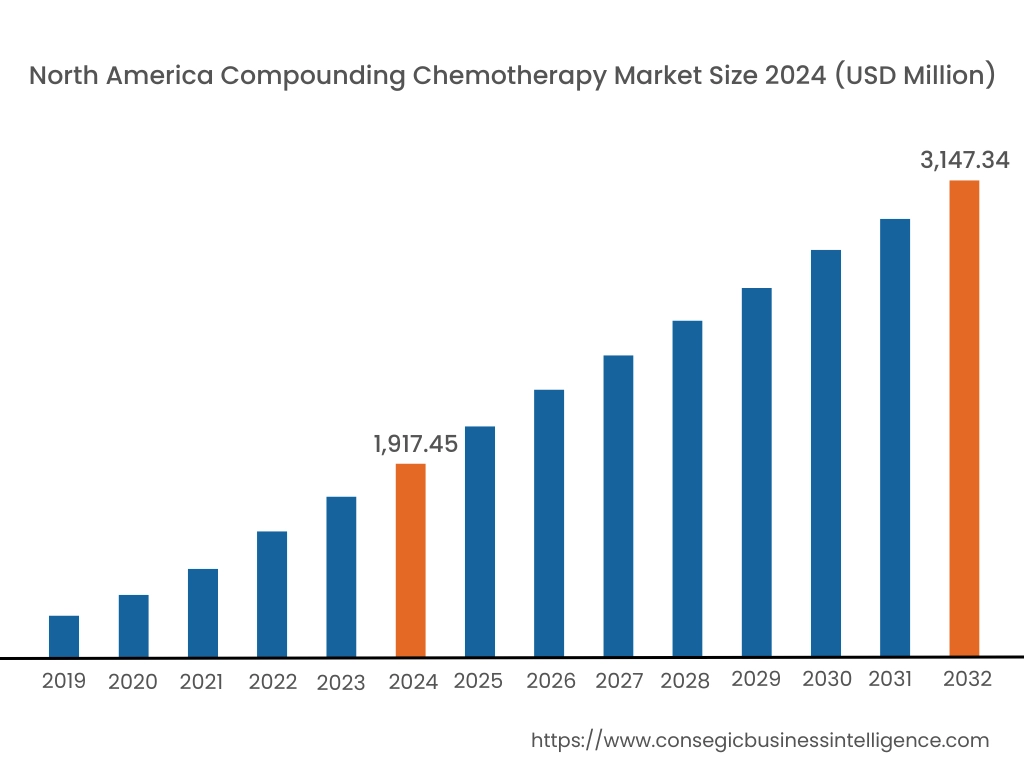
In 2024, North America was valued at USD 1,917.45 Million and is expected to reach USD 3,147.34 Million in 2032. In North America, the U.S. accounted for the highest share of 74.10% during the base year of 2024. North America leads the compounding chemotherapy market due to advanced healthcare infrastructure, a high prevalence of cancer, and stringent safety regulations for drug compounding. The United States accounts for the largest market share, supported by the presence of specialized oncology centers and compounding pharmacies. Increased government funding for cancer research and strong regulatory frameworks enhance market performance in this region.
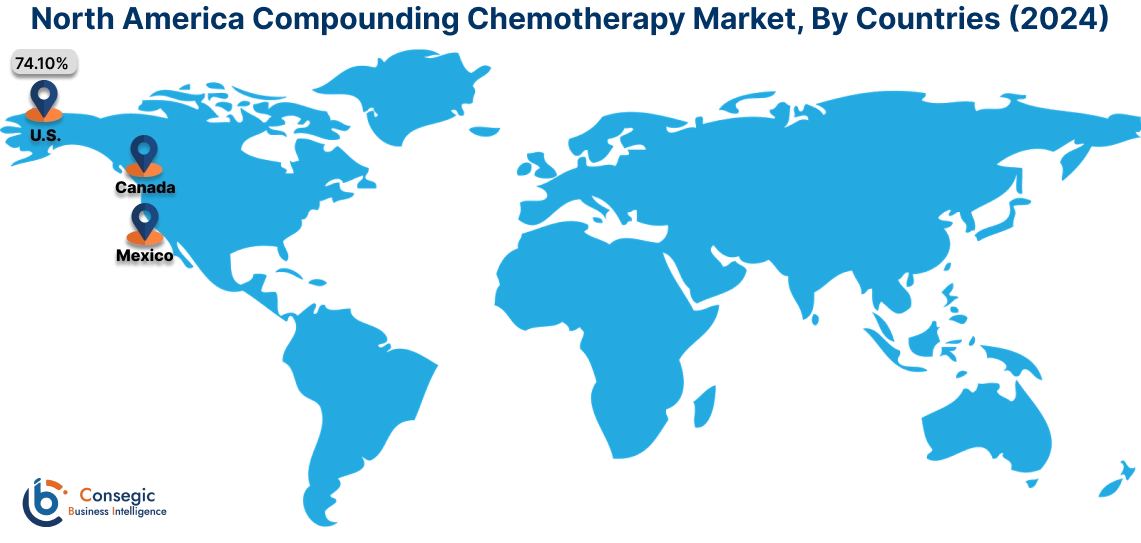
In Asia Pacific, the market is experiencing the fastest growth with a CAGR of 7.1% over the forecast period. Asia-Pacific shows significant growth in the compounding chemotherapy market, driven by increasing cancer incidences and improving healthcare systems in countries like China, India, and Japan. Expanding access to oncology care and the establishment of modern compounding facilities contribute to market progress. Regional challenges include ensuring compliance with regulatory standards and addressing the shortage of trained professionals in rural areas.
Europe is a prominent market for compounding chemotherapy, with countries like Germany, France, and the United Kingdom leading in adoption. A well-established healthcare system and high awareness about personalized cancer treatments support market development. The increasing demand for compounded chemotherapy drugs aligns with stricter quality standards and guidelines from regional regulatory bodies, ensuring patient safety and treatment efficacy.
The Middle East and Africa region experiences moderate development in the compounding chemotherapy market, primarily in Gulf Cooperation Council countries like Saudi Arabia and the UAE. Investments in oncology centers and rising cancer rates are influencing compounding chemotherapy market demand. However, in African nations, limited healthcare infrastructure and inadequate access to oncology treatments restrict compounding chemotherapy market trend. Efforts to enhance healthcare facilities and international collaborations aim to address these challenges.
Latin America shows steady progress in the compounding chemotherapy market, particularly in Brazil and Mexico. Rising cancer cases and efforts to strengthen healthcare systems contribute to compounding chemotherapy market demand. Challenges include the lack of advanced compounding facilities and the high cost of chemotherapy drugs. Regional governments and healthcare organizations are working to improve access to affordable oncology care and promote adherence to international compounding standards.
Top Key Players and Market Share Insights:
The Global Compounding Chemotherapy Market is highly competitive with major players providing products and services to the national and international markets. Key players are adopting several strategies in research and development (R&D), product innovation, and end-user launches to hold a strong position in the Global Compounding Chemotherapy Market. Key players in the Compounding Chemotherapy industry include-
- Baxter International Inc. (United States)
- Fresenius Kabi AG (Germany)
- Cardinal Health, Inc. (United States)
- Amgen Inc. (United States)
- Teva Pharmaceutical Industries Ltd. (Israel)
- Calea Ltd. (United Kingdom)
- Accord Healthcare Inc. (United States)
- Sandoz (Novartis) (Switzerland)
- Hospira (A Pfizer Company) (United States)
- ICU Medical, Inc. (United States)
Recent Industry Developments :
Mergers and Acquisitions:
- In January 2025, GSK was reported to be nearing a $1 billion deal to acquire IDRx, a U.S. biotech firm developing treatments for rare gastrointestinal tumors. IDRx's lead drug targets gastrointestinal stromal tumors (GIST), aiming to address resistance mutations that render current treatments ineffective.
- In February 2024, AbbVie acquired ImmunoGen for $10.1 billion, gaining access to ImmunoGen's antibody-drug conjugate (ADC) portfolio, including Elahere, approved for treating platinum-resistant ovarian cancer.
Compounding Chemotherapy Market Report Insights :
| Report Attributes | Report Details |
| Study Timeline | 2019-2032 |
| Market Size in 2032 | USD 9,711.02 Million |
| CAGR (2025-2032) | 6.7% |
| By Product Type |
|
| By Compounding Type |
|
| By Delivery Method |
|
| By Technology |
|
| By End-User |
|
| By Region |
|
| Key Players |
|
| North America | U.S. Canada Mexico |
| Europe | U.K. Germany France Spain Italy Russia Benelux Rest of Europe |
| APAC | China South Korea Japan India Australia ASEAN Rest of Asia-Pacific |
| Middle East and Africa | GCC Turkey South Africa Rest of MEA |
| LATAM | Brazil Argentina Chile Rest of LATAM |
| Report Coverage |
|
Key Questions Answered in the Report
How big is the Compounding Chemotherapy Market? +
In 2024, the Compounding Chemotherapy Market was USD 5,780.52 million.
What will be the potential market valuation for the Compounding Chemotherapy Market by 2032? +
In 2032, the market size of Compounding Chemotherapy Market is expected to reach USD 9,711.02 million.
What are the segments covered in the Compounding Chemotherapy Market report? +
The product type, compounding type, delivery method, technology, and end-user are the segments covered in this report.
Who are the major players in the Compounding Chemotherapy Market? +
Baxter International Inc. (United States), Fresenius Kabi AG (Germany), Calea Ltd. (United Kingdom), Accord Healthcare Inc. (United States), Sandoz (Novartis) (Switzerland), Hospira (A Pfizer Company) (United States), ICU Medical, Inc. (United States), Cardinal Health, Inc. (United States), Amgen Inc. (United States), Teva Pharmaceutical Industries Ltd. (Israel) are the major players in the Compounding Chemotherapy market.
